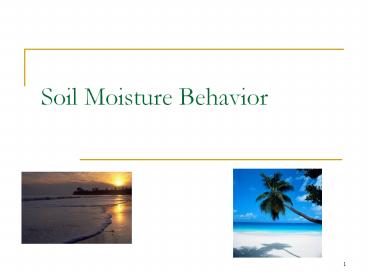Soil Moisture Behavior - PowerPoint PPT Presentation
Title:
Soil Moisture Behavior
Description:
Soil Moisture Behavior – PowerPoint PPT presentation
Number of Views:168
Avg rating:3.0/5.0
Title: Soil Moisture Behavior
1
Soil Moisture Behavior
2
Why is water important to plants?
- it is a nutrient
- serves as a solvent for other nutrients
3
What are the water requirements for plants?
- plants use several hundred pounds of water for
each pound of dry matter produced
4
How does water enter the soil?
- through pores in the soil
- sandy soils have the largest pores, but are often
filled with other material - medium textured soils (loamy) have good water
entry properties - clays, pores swell shut when they get wet
5
What is Adhesion?
- it is the attraction of two different molecules
(water to soil) - Water held by adhesion not available to the
plant
6
What is Cohesion?
- it is the attraction of two similar molecules
(water to water) - Water held by cohesion IS available to plant
7
What is the importance of adhesion and cohesion
in soils?
- water molecules are strongly attracted to soil
minerals and organic materials due to adhesion - water molecules are also strongly attracted to
each other due to cohesion - soil holds a thin layer of water, that layer
holds a thin layer of water etc., the farther
away from the soil particle you get, the looser
the water is held
8
What is the importance of adhesion and cohesion
in soils?
- water then tends to move from wetter places to
drier places. Roots remove water, then water is
drawn from surrounding areas - in dry conditions, water moves slowly and only
fractions of an inch, thus roots must be well
distributed
9
How is soil water classified?
- 1) Hygroscopic Water is held so strongly by the
soil particles (adhesion), that it is not
available to the plants - 2) Capillary Water is held by cohesive forces
greater than gravity and is available to plants - 3) Gravitational Water is that water which cannot
be held against gravity - as water is pulled down through the soil,
nutrients are"leached" out of the soil (nitrogen)
10
What is Field Capacity?
- when the soil contains the maximum amount of
available water, the greatest amount of water it
can hold against gravity
11
What is Wilting Point?
- the soil has so little water, that plants can no
longer recover from wilting - roots can no longer take in water
12
What is Available Water?
- the amount of water between field capacity and
wilting point
13
What is Water Table?
- the level beneath the soil which the soil is
saturated with water - marshes develop where the water table is just
below the ground surface - if the water table is not too low, dryness tends
to correct itself through capillary movement
14
What is saturation?
- When all pore spaces are filled with water
- Unhealthy state for plants when prolonged because
the oxygen dissolved in the water that is needed
for respiration is quickly utilized
15
What affect does soil particle size have on its
water holding ability?
- the smaller the individual particles are, the
more surface area there is, thus it will hold
more water - consider a book compared to all of its pages
16
How is soil moisture measured?
- soil is weighed dry, then wet (expressed as a
percent of dry wt) - electrical conductivity
17
What factors determine the amount of soil
moisture?
- amount of snow, rain, irrigation
- rate which soil permits water entry
- water storage capacity of soil
- evaporation rate
- height of water table
- rate which water can move within the soil
- amount and type of vegetation
18
How can we increase the amount of available water
to the plant?
- Precipitation better utilize snow and rain by
keeping the water on the soil surface. - windbreaks
- keep snow in place (cover)
- strip cropping
- contour strips
- grassland farming
- Irrigation may not be practical
- Water entry reduce cultivation, green manures,
correct alkaline soils
19
How can we increase the amount of available water
to the plant?
- Storage capacity increase O.M. (manures)
- Evaporation conservation tillage, shelter
belts, strip cropping - Water movement in soil O.M.
- Vegetative covering holds water
20
How much water do plants need?
- Transpiration Ratio pounds of water to produce a
pound of dry matter. - Corn 350 Wheat 500
- Potato 630 Grass Alfalfa 860
- It takes 4,533 gallons of water to produce enough
food for one person for 3 meals. (That's
1,654,545 gallons per year) - It takes 10,000 gallons of water to make one
bushel of wheat - It takes 7.35" of rain to make a 20 bushel per
acre crop.































